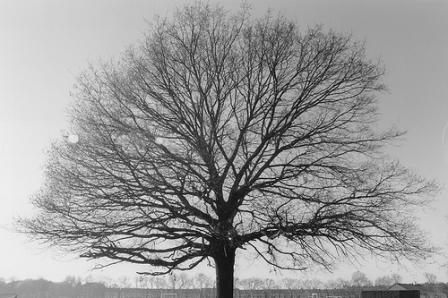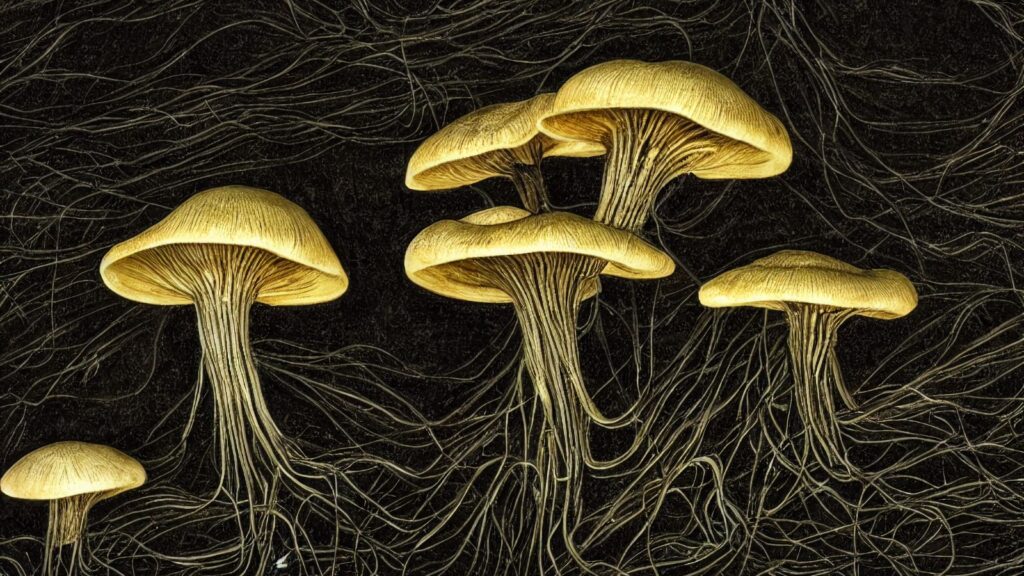This article originally appeared in Whole
Earth Review.
If you are fortunate enough to share a neighborhood with a
leafy elm, a gnarly oak, a soaring redwood, take another look at its silhouette
against the sky. That self-similar 4-D explosion of branching branches is a
clue to a cosmic riddle or two and a key concept in fields as unrelated as
vascular surgery and software design.
The Buddha knew this, and so do neurologists, database
programmers, and mythologists.
Axis mundi, the axis of the world, is the tree at the center
of everything sacred. Mythologist Joseph Campbell, referring to the Buddha's
awakening, noted that: "This is the most important single moment in
Oriental mythology, a counterpart of the Crucifixion of the West. The Buddha
beneath the Tree of Enlightenment (the Bo tree) and Christ on Holy Rood (the
tree of redemption) are analogous figures, incorporating an archetypal World
Savior, World Tree motif, which is of immemorial antiquity."
To Hindu dream adepts, the question of how you know that you
are awake is at once psychological and metaphysical. David Shulman, in Tamil
Temple Myths, discussing a character in a myth who realizes that he is dreaming
the tragedy of his life, notes: "The nature of his delusion is clear from
the moment he first catches sight of the upside-down tree — a classic Indian
symbol for the reality that underlies and is hidden by life in the world, with
its false goals and misleading perceptions."
To say nothing of the Garden of Eden and its two special
trees. Why do trees always happen to be on the set when God talks? It doesn't
matter whether your cosmology is Hebrew, Christian, Hindu, Buddhist, Pagan,
Shamanist or Animist: trees are always part of the scenery when a theophany
happens.
Tradition has it that the Buddha's tree was the type known
as "pipal" (ficus religiosa), and that it was precisely as old as the
fellow who sat down in its shade to catch a case of satori. The legends linking
"the one who awakened" and this particular variety of tree hold that
Sakyamuni, as he was known pre-enlightenment, had a lifelong habit of sitting
under papal trees that were exactly his age. It was also written that Buddha's
mother (aka Maya Devi) held onto the branches of a pipal when she
gave birth to him. This tree-grasping birth pose is important enough to rate
its own name: salabhanjka pose).
Why a tree? Why not a seashell, a lightning bolt, an old man
with a beard? The iconography is not strictly Asian. Ygdrassil, the world-Ash,
is Norse. The Druids were far from India and China. The theme surfaces in folk
tales, holy books, cave paintings, tiled mosques, and frescoed chapels in every
part of the globe. The Chinese saw it as a giant peach tree that bears the
fruit of immortality. Every year, as the winter solstice approaches, hundreds
of millions of Christians place a symbolic pine tree in their houses and cover
it with ornaments. The Yule log dates back to Druid and Celtic customs of
pre-Christian Britain, which at one time was covered in dense forests. In the
nineteenth century, German scholars discovered that the word temple is derived
from the Indo-European roots meaning "sacred grove."
The visual representation of a tree that branches at both
ends is a model of the universe as a living organism, a metaphorical map that
serves equally well for the cosmos external to the individual and the spectrum
of consciousness deep within — with its highest branches in the heavens and
its roots deep within the dark underrealm.
Are we also drawn to trees because our minds know that our
brain structures are tree-shaped? Do these signatures of our internal
informational systems keep emerging in symbols of our deepest religious
impulses because they are what nineteenth-century anthropologist Adolf Bastian
called Elementargedanken —
"elementary ideas" that are hardwired into our brains? Our nervous
systems are shaped like trees, and so are rivers, capillaries, data structures,
probability worlds, solution-spaces, chess games, and chain reactions. Our
ancestors lived in trees, not too long ago. It's no wonder that Sakyamuni sat
under one when he was ready to awaken.
Trees are talismans of sanity and wholeness to Western
psychotherapists as well as to Eastern mystics. According to Jungian
psychoanalysts, the appearance of a tree in a dream can be fortuitous, in the
sense that it often symbolizes, empowers, and heralds a movement toward
wholeness of the personality. Marie-Louise von Franz notes that:
"Since … psychic growth cannot be brought about by a conscious effort of will
power, but happens involuntarily and naturally, it is in dreams frequently
symbolized by the tree, whose slow, powerful involuntary growth fulfills a
definite pattern."
One characteristic that doesn't vary much from one tree to
another is the way components of the tree, the larger and smaller branches and
twigs, reflect the shape of the entire tree; a computer programmer would
recognize the tree as a "recursive structure" (because the same
pattern "recurs" at both the top and bottom levels of organization).
As the European alchemists of the middle ages would say: "As above, so
below."
This shape that makes trees and other things look treelike
brings a new perspective to several important questions about the way things
work: How can you keep track of a billion units of anything and make sure you
can find each unit as quickly as possible? How do you move things from one
point to many other points most efficiently? A recursive, branching, tree shape
is the visual analog of the answer for both questions.
A tree of the botanical variety is shaped that way because a
branching plant efficiently collects moisture from the earth via ten thousand
roots and distributes it rapidly to ten thousand leaves. (Kabbalism, the Jewish
mystical tradition, depicts the path to God-consciousness as a tree-shape with
the explanation that this is the way to distribute God-consciousness to
numberless sentient beings.)
Examine an aerial photograph of a river delta next to an
X-ray arteriogram of a human lung and you'll see that branches aren't limited
to forests. Rivers branch as they run into their own sedimentary deposits
because an arboreal shape is the most efficient way to distribute the river's
flow when the main channel suddenly becomes shallow. Pulmonary arteries branch because
the enables the lungs to distribute oxygen to the blood rapidly. The branching
of nerves and blood vessels in the brain is known as "arborization."
Quantum physicists even dreamed up fourth-dimensional trees.
Because of certain aspects of the equations describing the transformations of
electromagnetic energy, it is possible to hypothesize that the universe is an
infinitely branching entity. This formally permissible (if as-yet-unconfirmed)
logical consequence of the equations describing the transformations of
electromagnetic energy is known as "the many-worlds interpretation."
Your lifeline and mine, called "worldliness" by quantum physicists,
branch when we make decisions, take action, hesitate, move, or stand still.
There are worlds in which you are the Buddha and worlds that are exactly the
same as this one, except you part your hair on the opposite side. The abstract
space of such a universe, filled with infinities of non-intersecting branch
universes, is a fourth dimensional tree that grows at a rate incomprehensible
to 3-D mindsets.
A tree can be a map of space or time or psyche, or it can be
a map of information. Tree-shaped data structures are essential parts of all
computer software systems because trees offer an effective and orderly way to store
and retrieve large amounts of binary information. Trees in which each
branchpoint leads to exactly two branches is the direct visual analog of a
binary code, because you can get from the trunk to any one of the leaves by
making either one of two decisions at each branchpoint.
You could assign a unique address to every leaf on a tree by
specifying the binary decisions that a bug would have to make directly from the
trunk to that leaf. You could specify the leaf on the first right branch after
the first left branching of the right fork of the main trunk and call it
"right-left-right," or, for that matter, "010" or
"101" — which happens to be the fundamental alphabet of digital
computers.
To programmers who are trying to write software to emulate
human problem-solving, tree-shaped strategies are "a way to fan out
quickly into a solution space." The first computer chess programs tried
the "brute force" method of evaluating the consequences of every
possible move at every step of the game, but the most powerful computers then
and now bog down in the explosion of possibilities that happens if you try to
look down too many branches in a recursively branching structure. It was Claude
Shannon, the father of information theory, who demonstrated that the explosively
branching tree of possibilities is destined to destroy any brute-force approach
after only a few steps. Among AI programmers, the creation of increasingly
effective search-tree-pruning algorithms has become a grail.
Kids know about trees, and the easiest way to remember what
the world like when you were a kid is to climb a tree. Kids climb them, lie
down under them and look up at the dappled sunlight, hang swings from them,
build houses in them, paint pictures of them, collect their leaves. Today's kids
know that trees are disappearing because of human activity, and they know that
trees are the lungs of the biosphere. Which means the act of planting a tree
with a child has taken on ecological as well as psychological and spiritual
significance. Years ago, I discovered a Bantu word that can teach us something
valuable: mahamba.
A mahamba is a "spirit-tree" that is planted when
a child is born. Can we make tree-planting both a part of family life and a
sacred act again? We could start with a new meme – an idea deliberately
designed to be infectious.
As soon as possible after birth, take the child and its
parents to plant a mahamba. Make sure that the tree is native to the local
environment and that it will be accessible in the future. Finding a proper place
to plant and obtaining an appropriate seedling might not be easy; overcoming
these obstacles is the spiritual offering of the child's sponsor. As soon as
the child is able to walk, bring him or her out to meet the tree and to feed
it.
Encourage the child to take over the care and feeding, and
seal the responsibilities with gifts. Continue reinforcing the merit to be
gained from the act, in whatever terms the child understands: The legend of a
tree that brings good fortune might be one of those harmless myths that can
teach more than a hundred hard facts. And the simple act of nurturing a tree,
distributed memetically, repeated recursively, might help our species get a
grip on our planet's runaway throttle.
Notes:
Martin Buber, I and Thou,
Scribners, 1958.
Joseph Campbell, The Hero With a Thousand Faces, Princeton University Press, 1949.
V.S. Nararane, The Elephant and the Lotus, Asia Publishing House, 1965.
M.S. Randhawa, The Cult of Trees and Tree Worship in
Buddhist-HinduSculpture, All India
Fine Arts and Crafts Society, New Delhi, 1964.
David Shulman, Tamil Temple Myths, Princeton University Press, 1949.
Marie-Louise von Franz, "The Process of
Individuation," in C.G. Jung, Man and His Symbols,
Doubleday 1964.
Image by deraliedbytrain, courtesy of Creative Commons license.















